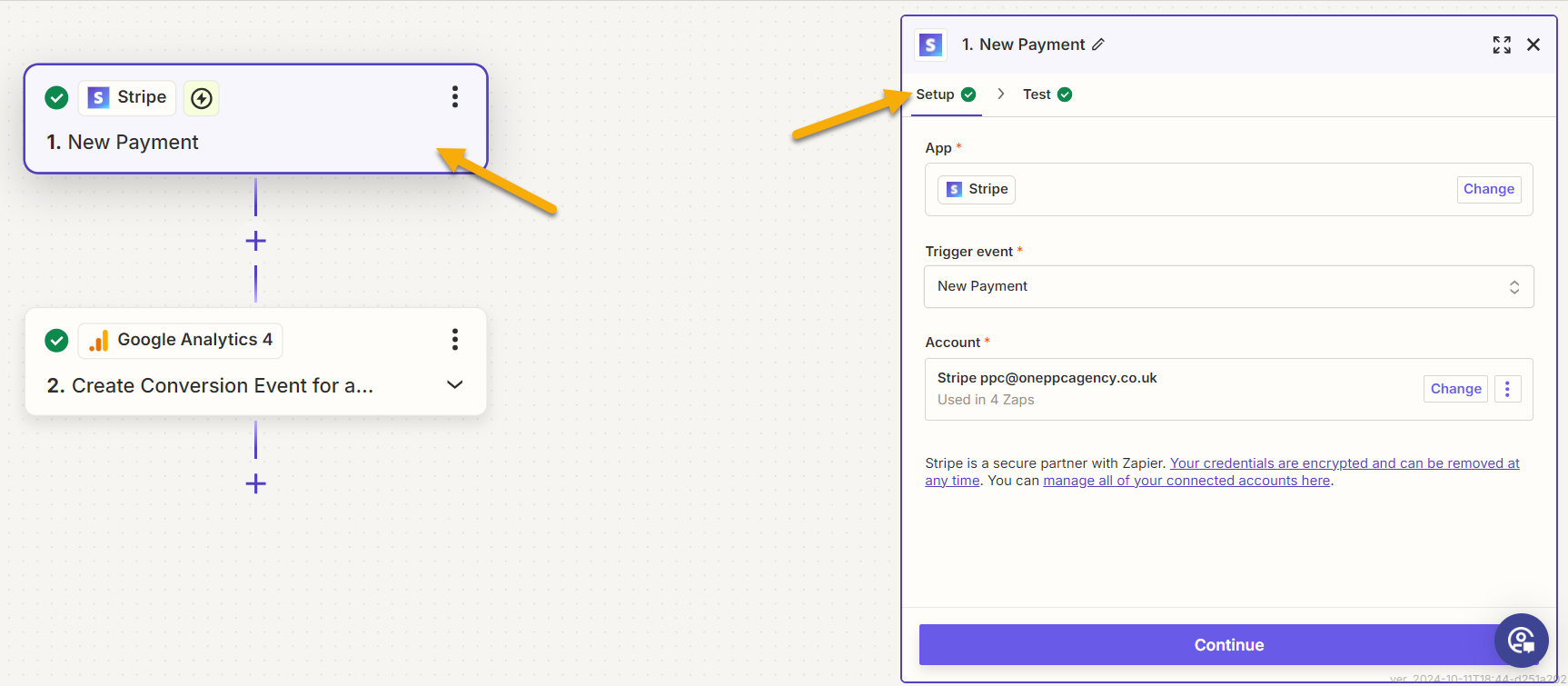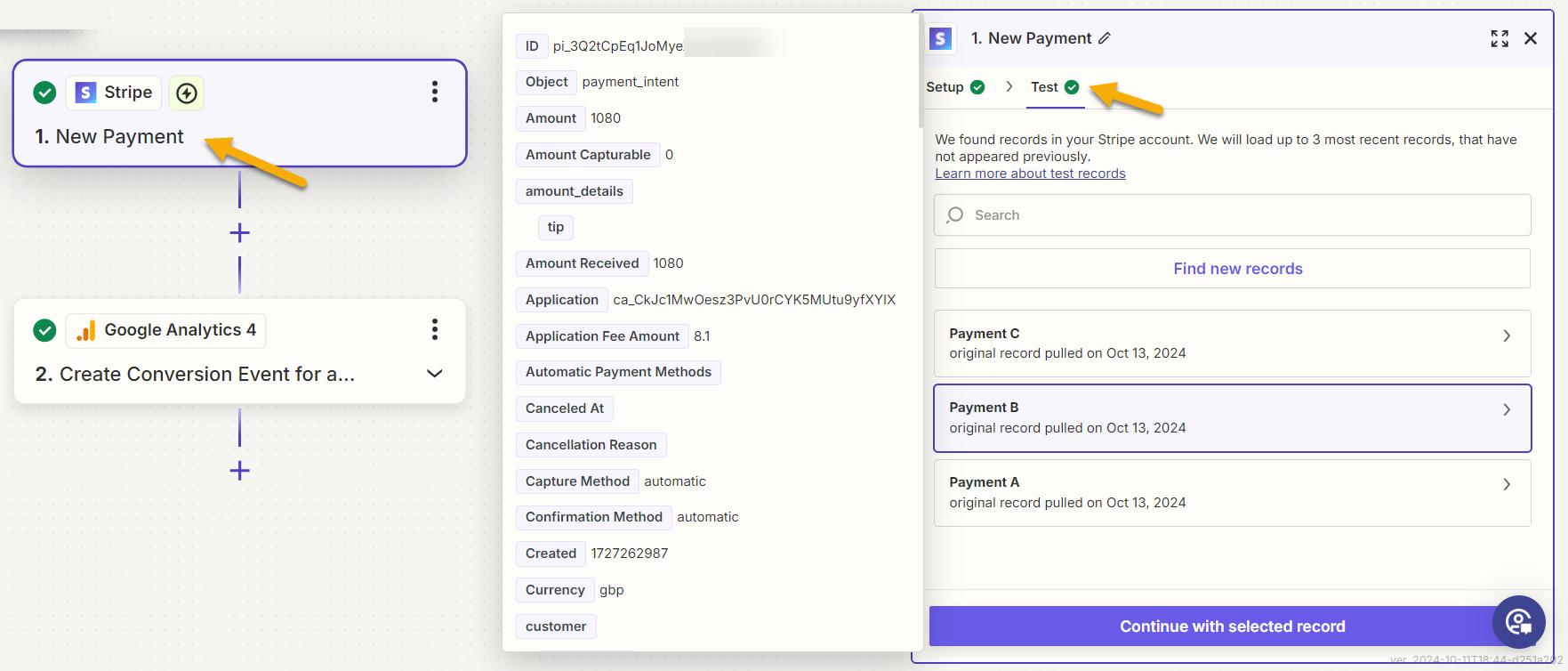In the competitive landscape of digital marketing, the ability to capture and analyse detailed customer transaction data can significantly enhance marketing strategies and improve user experience. This guide will explore both the theoretical and practical aspects of integrating Google Analytics 4 (GA4) with Stripe using Zapier. This process enables UK businesses like yours to track conversions effectively and gain deeper insights into sales funnel dynamics, enhancing your digital marketing capabilities.

Theoretical Foundations
Google Analytics 4 (GA4) is a powerful analytics tool that represents a shift from session-based data to an event-based data model. This shift allows for more comprehensive and granular tracking of user interactions across platforms. GA4’s flexibility makes it ideal for integration with payment systems like Stripe, facilitating detailed monitoring of events such as transaction completions.
Stripe is a versatile payment processing platform with an API-first design, supporting robust customisation and easy integration with other tools. When you track transactions through Stripe as conversion events in GA4, you obtain valuable insights into customer purchasing behaviours and trends, which is crucial for refining your PPC campaigns and optimising ROI, as discussed in our previous conversations about Google Ads integration.
Zapier serves as the glue that connects Stripe and GA4, enabling these integrations without extensive coding through its automated workflows or Zaps. This simplifies the passing of information between systems whenever specific events occur, such as successful payments.

Strategic Benefits
- Enhanced Data Collection: Integrating Stripe and GA4 allows businesses to correlate specific payment events directly with user engagement and acquisition metrics, enriching your data-driven strategy.
- Real-Time Analytics: The automation ensures data is transferred instantly, enabling real-time analysis and allowing businesses to adapt quickly to emerging trends.
- Automated Workflows: By automating data transfer, Zapier minimises the potential for errors and operational overhead, freeing up resources for other strategic initiatives.
Prerequisites
Before setting up this integration, you’ll need:
- Google Analytics 4 Account: Configured to your business website.
- Stripe Account: Ready to handle transactions.
- Zapier Account: With a suitable plan for your automation needs.
- Basic Technical Proficiency: Understanding of the platforms involved.
Step-by-Step Integration Process
Here’s how you can set up a Zapier integration between Stripe and Google Analytics (GA4) to track conversions when a payment is processed. I’ll break it down step-by-step according to your updated requirements.
1. Start with Stripe as the Trigger App
Trigger App: Stripe
Use Stripe as the app that triggers the workflow (Zap).Trigger Event: New Payment
Select New Payment as the trigger event. This will fire whenever a payment is processed in Stripe.Connect Stripe:
Use your email to log in to your Stripe account and authorize Zapier to access your Stripe data.Run a Test:
Run a test in Zapier. This will pull in details from a recent Stripe transaction, such as:- Customer email address
- Payment amount
- Product name
- Billing and shipping addresses (if applicable)
- Other transaction data like currency and payment method.
Step 2 - Add Google Analytics as the Action App
Action App: Google Analytics 4
Add Google Analytics as the app to perform an action when the Stripe trigger fires.Action Event: Create Conversion Event for a Property
Select “Create Conversion Event”. This action will send a custom event to your GA4 property when a new payment is processed in Stripe.
Step 3. Create Action App for Google Analytics
Google Analytics Account:
Select your Google Analytics account to connect it to this Zap. You may need to authorize Zapier to access your GA4 data.Select Google Analytics Property (GA4):
Choose the GA4 property where you want to track the conversion events from Stripe.
Step 4: Configure the Conversion Event
Event Name: Enter a custom event name for the conversion. You can either:
- Create the event name in Google Analytics first, then copy it exactly into Zapier.
- Or, create the event name in Zapier directly. Google Analytics will automatically register the event name the first time the conversion occurs.
Examples of event names:
stripe_purchasepayment_successcheckout_complete
6. Test the Zap and Go Live
Test the Zap:
Run a test using a real or recent Stripe transaction. Verify that the conversion event is correctly sent to Google Analytics.
Activate the Zap:
Once the test is successful, turn on your Zap to start tracking future Stripe payments as conversion events in GA4.
Additional Considerations
Yes, there are several additional aspects and considerations that could further enhance the utility and comprehensiveness of integrating Google Analytics 4 with Stripe using Zapier:
Privacy and Data Security: Discuss how data privacy regulations such as GDPR or the UK’s Data Protection Act impact the collection and processing of customer data. Include best practices for handling personal data securely, especially when transmitting between services like Stripe, Zapier, and Google Analytics.
Advanced Segmentation and Analysis: Explore how to use GA4’s advanced segmentation features to analyse the Stripe transaction data more deeply. For instance, creating user segments based on purchase behavior or transaction size could yield more nuanced insights into different customer demographics.
Error Handling and Monitoring: Provide guidance on setting up alerts and monitoring systems within Zapier or GA4 to quickly identify and address any issues in the data flow or integration setup. This ensures reliability and accuracy in the tracking of conversion events.
Cost Management and Scaling: Discuss potential costs associated with using Zapier, especially for businesses with a high volume of transactions. Offer strategies for managing these costs and scaling the integration as the business grows.
Long-term Impact and ROI Analysis: Address how to measure the long-term impact of this integration on business performance and ROI. Include metrics to track and methods for attributing improvements in sales and marketing performance directly to changes made based on analytics insights.
Integration with Other Marketing Tools: Consider how this integration fits into a broader digital marketing ecosystem. Discuss potential integrations with other tools (e.g., CRM systems, email marketing platforms) to create a holistic view of customer interactions across multiple touchpoints.
A/B Testing and Conversion Optimisation: Explain how to conduct A/B testing on different elements of the sales funnel using data from GA4 and Stripe. This could help optimise conversion rates by testing different checkout processes, payment options, or promotional offers.
Including these topics could provide a more holistic view and offer practical advice that spans beyond just setting up the integration, helping businesses leverage the full potential of their digital analytics and payment processing systems.
Conclusion
This integration framework not only improves the granularity and accuracy of your analytics but also automates the process, significantly reducing overhead. By following this guide, UK businesses like yours can leverage advanced digital analytics to drive informed decisions and foster substantial growth, reflecting the strategic approaches we’ve discussed in enhancing your digital marketing ecosystem.